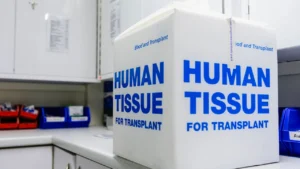4 Cool Facts About Cold-Chain Packaging

At a Glance
- Cold-chain packaging is critical for safely transporting vaccines, lab samples, blood products, biologics, and more.
- Controls, tracking, and monitoring ensure package contents reach their intended recipients at their right concentrations.
- Brush up on your cold-chain technology, preservation, quality, and sustainability facts.
Cold-chain packaging is the first line of defense for perishable drugs. Many of these — especially those used for treating chronic conditions — are fragile and can deteriorate with brief exposure to the sun, ambient temperature, and other outdoor conditions. Leftovers are refrigerated to maintain their freshness and quality — medications have a cold chain for the same reason. Learn more facts about cold-chain packaging and why it’s essential.
Why is cold-chain packaging important?
Some drugs are sensitive to temperature, so they must be encased in special containers to protect their integrity during shipments. Cold-chain packaging uses thermal and refrigerated solutions to transport vaccines, diluents, lab samples, blood products, and biologics from the manufacturer to patients. Since these things can degrade at a slight temperature change, their logistic environment must be controlled, tracked and monitored to ensure they reach the intended recipients at their right concentrations.
Thermodynamics back cold-chain packaging.
The science behind cold-chain packaging’s effectiveness in preserving drugs to perfection is based on thermodynamics, which is the relationship between temperature, heat, and other forms of energy. Humidity can alter the drugs’ characteristics, especially biologics that are created from humans, animals, and other microorganisms. They’re at a greater risk of contamination during shipment than conventional medications.
Cold-chain storage solutions are well-equipped to prevent heat from entering or escaping the containers, allowing for a more stable preservation temperature. Some examples are compression and absorption refrigeration, thermoelectric cooling, advanced insulation, and solar-powered containers.
Below are four key facts you should know about cold-chain packaging to brush up on the basics, deepen your knowledge, and consider areas for further investigation.
01 Cold-chain packaging can be made more sustainable.
Today’s consumers are willing to pay 10% more than the original price for an eco-friendly product. The media has ballyhooed sustainability to the public. As a result, people are compelled to choose environmentally safe alternatives to almost everything, including their medications.
The initial impression of cold-chain packaging is it’s a power guzzler. It uses energy-consuming refrigerators, which require round-the-clock power to operate. However, these aren’t the only vehicles for keeping products intact during logistics.
Cold packaging solutions can be active, passive, or hybrid. Active methods use energy-consuming mechanical and electrical systems. Passive, on the other hand, is sustainable since it uses eco-friendly refrigerants and insulated boxes. Containers are also reusable, so less waste is generated during shipments.
Lining containers with coolant packs can keep medications, vaccines, and diluents cold until they’re ready for use. Such solutions reduce the demand for energy and make delivery efficient.
02 Cold-chain packaging preserves drug quality.
COVID-19 vaccination programs were successful because of efficient cold-chain logistics and packaging. It has allowed wider distribution of effective immunization and booster shots from warehouses and healthcare facilities to people in remote areas.
Vaccines and some modern drugs contain biologics that are vulnerable to temperature fluctuations. They can decompose and become ineffective if the right refrigerating point isn’t maintained. Shipping delays and sun exposure can also decrease their concentrations.
Cold-chain packaging can keep the right environment for these medicines to stay in perfect condition until they’re ready for use.
03 It reduces spoilage rates and prevents loss.
Spoilage can occur when storage temperature fluctuates between 8 to 12 degrees Celsius during transit. While this is expected to some degree, the real harm is with the drugs. Some biologics may produce toxins that, when accidentally administered, may result in adverse reactions. Liquid vaccines can also lose their potency when briefly exposed to freezing temperatures. They won’t cure the patients once their quality deteriorates. This often leads to the loss of public confidence in vaccines and extra doses for recipients.
Cold-chain packaging can help prevent this from happening. As long as the products are kept safe at recommended temperatures in sealed containers, it can minimize the impact of lapses in delivery, prolong the drugs’ shelf life, and decrease the rates of ruined medications.
04 It’s adopting more IoT and RFID technology.
About 4.5 trillion drugs are manufactured annually, but $35 billion of medicines are lost to broken cold-chain logistics and never reach the patients who need them. Optimizing the shipment process can minimize waste and ensure the products’ quality. One method to bolster the cold chain is modernizing existing packaging measures, which many manufacturers have already embraced.
Integrating the Internet of Things (IoT) enables them to get real-time shipment data and immediately respond to problems during distribution. Smart technologies use sensors and radio frequency identification (RFID) tags to monitor the temperature throughout transportation. Polygon geofencing creates a virtual footprint of the destination, informing everyone in the supply chain of the exact delivery date. Innovations like these gradually replace outdated solutions to make the process more efficient.
Cold-chain packaging innovations continue evolving.
Billions of people will benefit from efficient cold-chain packaging. Fortunately, the outlook for innovations in this domain is optimistic. Pharmaceutical companies consistently improve their processes by incorporating the latest technology to expand patients’ access to much-needed medications.
Article source: Packaging Digest









